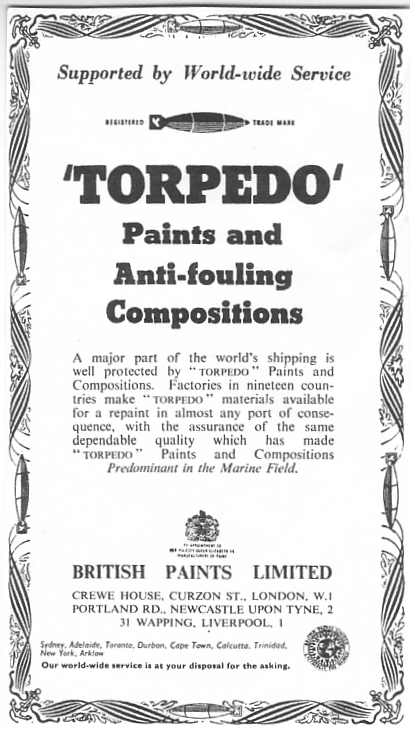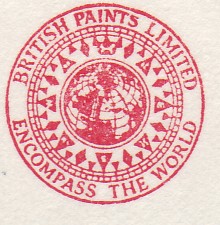|
The History and Origins of the Old Paint Company ~ British Paints |
|||||||||||
|
The following brief history of British Paints is based on information received from: Brian Law, Bob Hanson, Jack Bravey, John Balfour, Bob Batey and Derk Aldis. |
|||||||||||
| British Paints | |||||||||||
|
It is said that British Paints was created through the drive of one man ~ James W. Adamson. Jimmy, as he was better known, started his working life with a ships chandler. He soon realised there was money to be made in paint and began manufacturing his own products, which he sold from a horse and cart to the many ships tied up on the River Tyne at South Shields. |
|||||||||||
|
By 1919, he had his own paint production at his own company G. A. Frater Paints Ltd located on the banks of the Tyne in Gateshead. [we are not certain where the name G A Frater came from or whether simply Jimmy purchased or went into partnership with an established company.] The first acquisition, obtained in partnership with Charles Linder, took place in 1922. This involved J. Dampney Limited, a Cardiff paint company established in 1897 and specialising in marine products, a significant proportion of which was exported. One of the people transferred from Cardiff was W. P. Jenkins, who became Chief Chemist of British Paints and was one of the driving forces in the formation of the Newcastle company. Manufacturing at Cardiff soon ceased and everything was transferred the Gateshead site. The merged company was renamed the Dampney Paint Company Ltd. |
|||||||||||
|
|
|||||||||||
|
|
|||||||||||
|
A period of takeovers then started, first with the acquisition of the Holmes Group in 1928. was taken over: this involved W. H. Holmes paint-makers and J. H. Holmes electrical component manufacturers. The electrical business was of no interest and was immediately sold to Reyrolles of Hebburn. Meanwhile, the Gateshead plant was operating at full capacity and the decision was taken to move the operation to a much larger site north of the Tyne at Portland Road, Newcastle upon Tyne. |
|||||||||||
|
A period of further acquisition then started. In rapid succession Hoyle, Robson and Barnett Ltd. (est 1789), J. & W. Wilson Ltd. of Liverpool (founded before 1800), the British Anti-foulingCompany of Barking, Essex (established 1892) bringing with it The Federal Paint Company of New York, Hall Dunbar of Edinburgh, W. L. Ames of Glasgow, Charles Credland of Sheffield and John Smith [a varnish company] of Haltwhistle were all taken over. Most production was concentrated on the Portland Road site but manufacturing survived at Liverpool, Barking and New York at least until the 1960’s. |
|||||||||||
|
After a difference of opinion with the new management, two of the directors of Hoyle Robson and James Barnett left the company and set up their own operation at Haltwhistle under the name Smith & Walton Ltd. (This company had no connection with the varnish maker John Smith of Haltwhistle mentioned above). |
|||||||||||
| In the 1930`s, production facilities at Portland Road were extended with the construction of a new paint factory, but any thoughts of further expansion had to be put on hold due to the outbreak of the second world war. As a patriotic gesture, the company name was changed to British Paints Limited in 1940. After the end of hostilities, rapid growth was again resumed; but this was mainly overseas with paint plants being purchased or built in what were mainly the former British Empire countries. By the 1960`s the name of British Paints was well established in Australia, Canada, the West Indies, India, Pakistan, Ireland, Malta, Singapore, New Zealand, the USA and much of Africa. Although Portland Road continued to be the head office of the worldwide operation and the central research and development facilities were located there, the UK ceased to be the largest part of the organisation, with the privilege being transferred to Australia. British Paints was active in nearly all the paint market sectors but was especially strong in marine paints, becoming one of the largest world producers. | |||||||||||
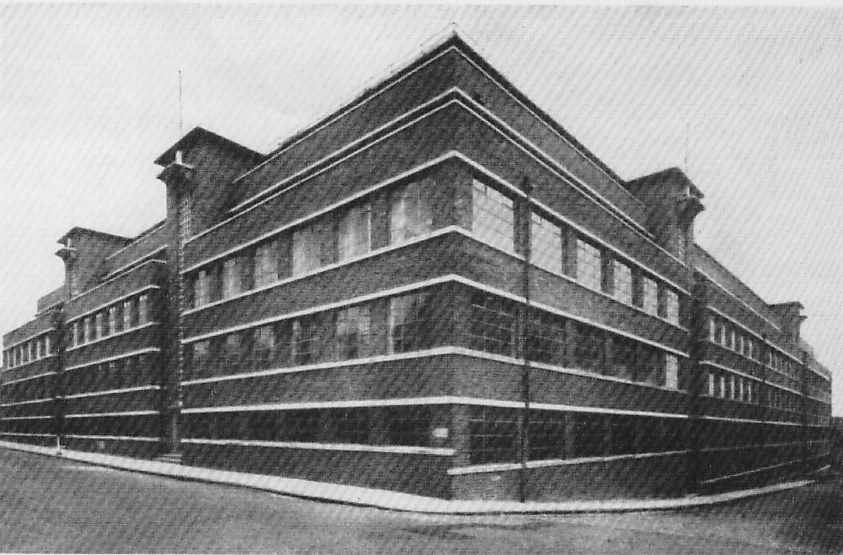 |
|||||||||||
|
British Paints works building circa 1940 |
|||||||||||
|
After the end of hostilities, rapid growth was again resumed; but this was mainly overseas with paint plants being purchased or built in what were mainly the former British Empire countries. By the 1960`s the name of British Paints was well established in Australia, Canada, the West Indies, India, Pakistan, Ireland, Malta, Singapore, New Zealand, the USA and much of Africa. Although Portland Road continued to be the head office of the worldwide operation and the central research and development facilities were located there, the UK ceased to be the largest part of the organisation, with the privilege being transferred to Australia. British Paints was active in nearly all the paint market sectors but was especially strong in marine paints, becoming one of the largest world producers. |
|||||||||||
|
Until the late 1930`s, the majority of paint binders were based on natural products such as linseed oil or fossil gums. Properties could be improved by “bodying” the vegetable oils or using varnishes (natural resins “cooked” into oils), but many aspects of performance such as yellowing were still not very good. However, research being done in various parts of the world indicated that further improvements could be obtained through chemical modification of these substances. Thus came about the first synthetic resins.
|
|||||||||||
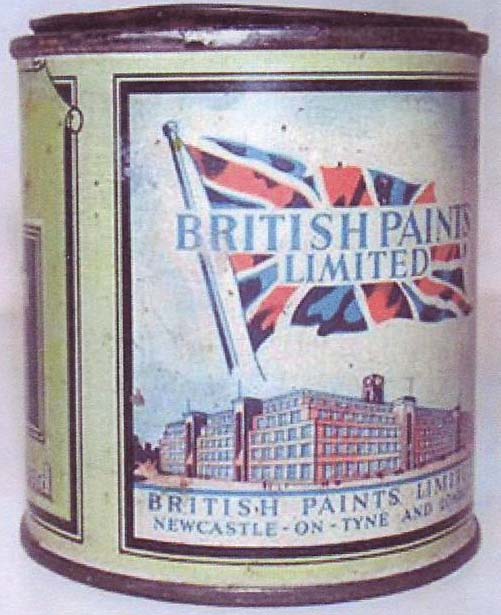 |
|||||||||||
|
n 1937, British Paints estimated they had a requirement for synthetic resins of about 100 tonnes per year. Due consideration was given as to how this demand could be fulfilled and the management of the day took what was to be a very far-reaching decision; it was agreed that the necessary equipment be installed to manufacture synthetic resins in-house. The resin plant consisted of a 1 cubic metre kettle heated directly by gas, a 2 cubic metre mixer and an intermediate vessel with a capacity of about 500 kilos. Formulations were licensed from Gustav Roth of Hamburg, Germany and the products manufactured were alkyds and rosin modified phenolic and maleic resins. At that time, bisphenol A, which was (and is still) used in the rosin modified phenolic resin formulations, was not readily available and a crude form of this material was made in the intermediate vessel. The plant was erected at Portland Road and the first batch of resin made in January 1938. In total, 88 tonnes were made in the first year of operation. |
|||||||||||
|
|
|||||||||||
|
Copy of an advert from the book 'The birth & history of Trinity House', Newcastle-upon-Tyne |
|||||||||||
|
With the outbreak of the Second World War in 1939 it was foreseen that the availability of natural products for paint making would become limited and emphasis would shift to synthetic resins. However, to make any significant increase in production it was realised that additional plant would have to be installed. Unfortunately, at that time, most steel production was being directed into the war effort and so the chance of being able to obtain new resin kettles was almost impossible. The decision was therefore taken to modify the recently installed mixer and intermediate vessel to make them suitable as primary production units. The work was carried out at top speed and they became available as resin kettles in 1940 when production was immediately boosted from 100 to 500 tonnes per year. For a number of years, British Paints had had its own varnish making facilities at the Portland Road site and this included a 5 cubic metre vessel for making blown linseed oil. This was also modified to make alkyd resins and production was soon to be increased to around 900 tonnes per year by 1941, representing a ten-fold increase in resin manufacture over a 3-year period! |
|||||||||||
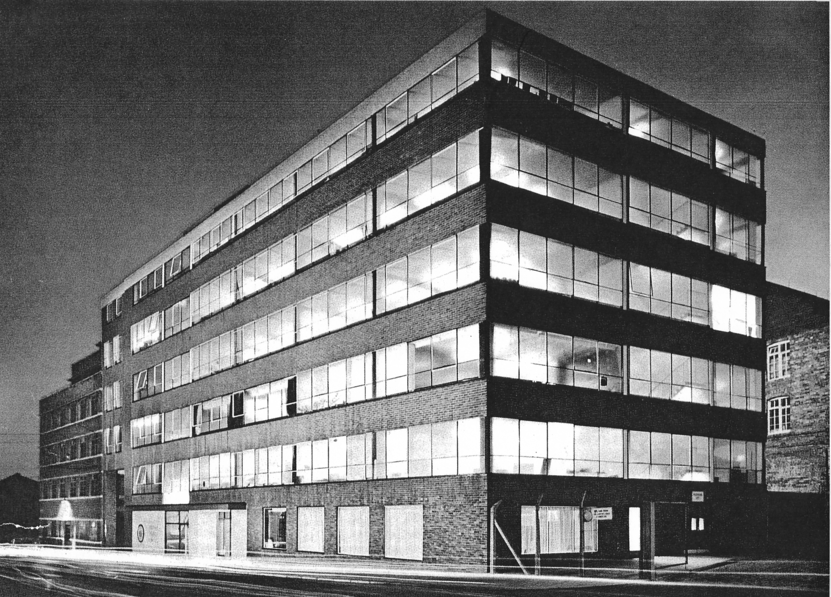 |
|||||||||||
|
British Paints Research Laboratories Portland Road Newcastle- on Tyne |
|||||||||||
|
Largely on the advice of the Technical Director, George Weatherston, the board of British Paints recognised that the use of unmodified natural products as paint binders was set to decline even further and the bold decision was taken in 1941 to order a 5 cubic metre alkyd kettle. Due to wartime controls and bureaucracy, coupled with a shortage of stainless steel, this kettle could not be delivered until late 1943. |
|||||||||||
|
Largely on the advice of the Technical Director, George Weatherston, the board of British Paints rec-ognised that the use of unmodified natural products as paint binders was set to decline even further and the bold decision was taken in 1941 to order a 5 cubic metre alkyd kettle. Due to wartime controls and bureaucracy, coupled with a shortage of stainless steel, this kettle could not be delivered until late 1943. Such was the board’s faith in technological change that another kettle was ordered even before the first one was delivered. |
|||||||||||
|
By the second half of the war, the threat from enemy bombing had receded and it was decided to use Dunston for resin manufacture. The first new kettle was installed in late 1943 and the following year saw the original plant transferred from Portland Road. From 1944 all resin production was concentrated at the Dunston site and additional new 5 cubic metre kettles continued to be installed until 1953. Apart from some of the very small kettles, all are mostly still in use bearing their original numbers. |
|||||||||||
|
British Paints had always been a technically led organisation and with developments in resin technology proceeding apace, especially away from a war-torn Europe, the decision was taken to obtain know-how from the USA. Not only were products for surface coatings licensed but there was also interest in resins for other applications as well. Originally conceived as a supplier to the parent paint company only, it was decided to expand activities by selling to external customers. There was however a perceived problem, i.e. that of British Paints seen to be selling resins to its competitors in the paint industry; so, it was decided to set up a separate operation to sell the resins outside. It was during a visit George Weatherston made to Rohm and Haas in the USA, that he noticed their resins were being sold under the name of Resinous Products. This gave him the idea of a suitable name for the embryo resin division and so it was on the first of January 1950 that Resinous Chemicals Limited came into being. |
|||||||||||
|
One of the product types included in the various licensing agreements was phenol formaldehyde resins or phenolics as they were often known and moulding compounds based on these resins were one of the first plastic materials available. A small plant was set up at Dunston in 1947 to manufacture phenolic moulding compounds which were used for making such things as distributor caps for cars and light switches. Meanwhile the parent company had acquired a new site further up the Tyne at Blaydon and the moulding compound venture was soon transferred there. As well as moulding compounds, the Blaydon site soon began to manufacture decorative laminates which also used phenolic resin produced at Dunston. This type of material is better known by the brand name of a competitive product, i.e. “Formica”. The laminate operation went under the name of North British Plastic. A third product type was also manufactured at Blaydon, namely shell moulding compounds. These contained ground up solid phenolic resins, also produced at Dunston, and in combination with sand were used for making foundry moulds and grinding wheels. |
|||||||||||
|
In 1965 Jimmy Adamson, the founder of British Paints was looking to retire and a bid was received from the Celanese Corporation of America. Celanese were essentially manufacturers of man-made fibres; they owned a number of paint companies with associated resin making facilities in North America and were interested in expanding their operations outside the USA. The bid was duly accepted and British Paints, including RCL passed into American ownership. At almost exactly the same time the North British Plastics operation which had become hopelessly uneconomic was closed down. Shortly afterwards paint production ceased at Liverpool and Barking |
|||||||||||
|
It was the stated intention of Celanese to invest in the UK operations of British Paints which had been neglected for a number of years. The new American owners were especially strong in automotive finishes and substantial business was gained with the Ford Motor Company. As a result, additional paint making facilities were needed and the decision was taken to build a new factory on the Blaydon site for both automotive and industrial finishes. This meant RCL had to vacate Blaydon altogether; the AMC laboratories were moved to the AMC production department at Dunston and the shell moulding operation which had suffered a considerable decline in business was also transferred to Dunston. The sales office was temporarily relocated to the attic of the Portland Road office block prior to moving to Dunston. Nevertheless the new investment had a positive effect on resin production with the manufacture of a new generation of acrylic, amino and short oil alkyd resins. Celanese also held patents on high solids emulsions for decorative paints and production of these commenced at Dunston in 1967. Although they subsequently sold the rights, Celanese had been inventors of epoxy resins and these products were also made at Dunston. The plant (kettle 26) was not really suited to the manufacture of epoxy resins and so production was soon abandoned. |
|||||||||||
| Logos | |||||||||||
| We are a bit uncertain of the British Paints logos as these seemed to have changed over the years. We have from Derek Aldis, who was employed at the British Paints Barking factory, a logo dated 1967 | |||||||||||
|
|
|||||||||||
| There is also a logo that appeared on a British Paint's colour-card for their Luxol range | |||||||||||
| It has also been suggested that a torpedo was used as a trade mark. Can anyone clarify any of this ? | |||||||||||
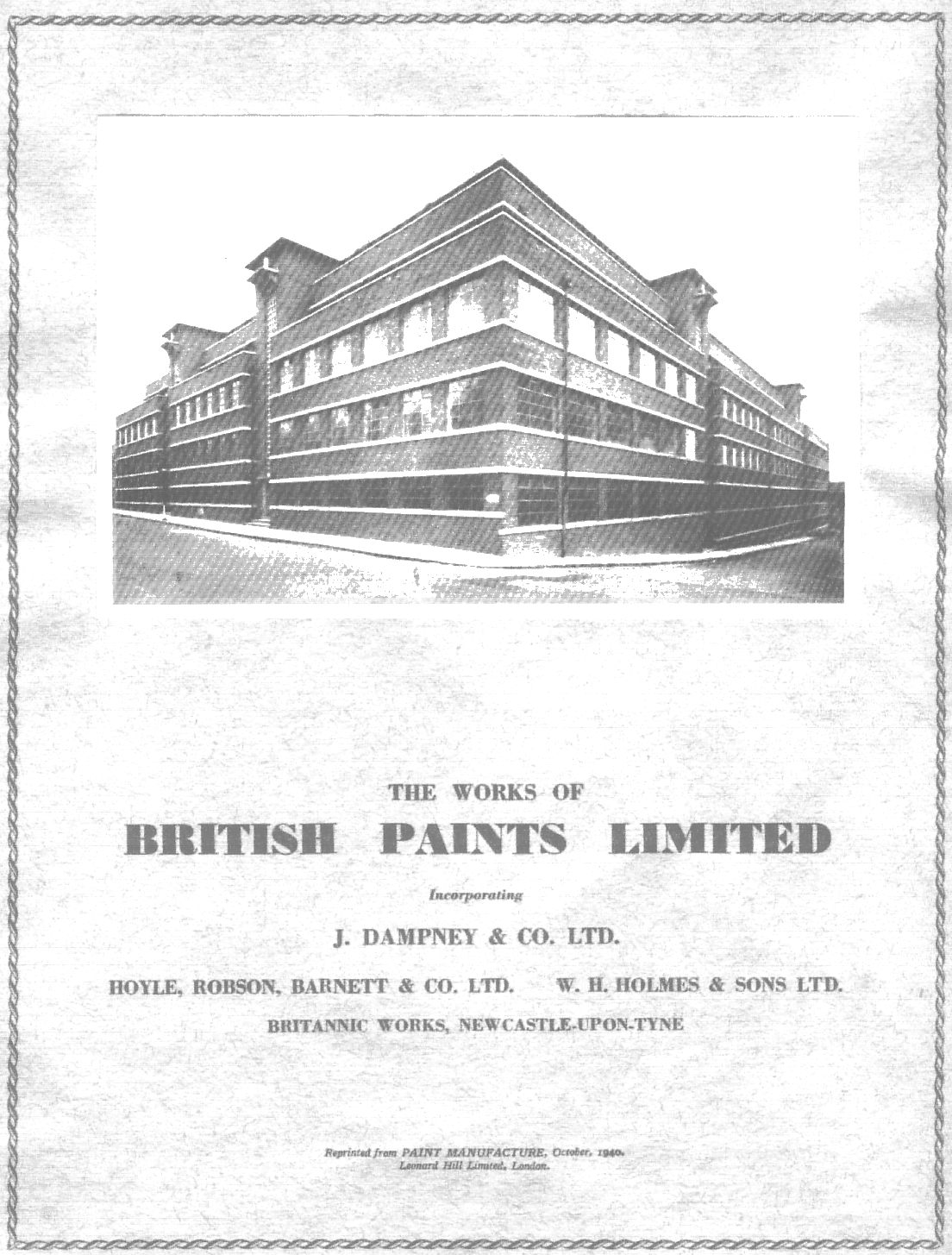 |
|||||||||||
|
The following brief history is based on information received from Garry Lall a painter and decorator in Newcastle, who has developed an interest in the growth/history of paint manufacturing in the North East. To view this history please click on the Link below. | |||||||||||
|
|
|||||||||||
Additional information to the history of British Paints is most welcome.
|
|||||||||||
